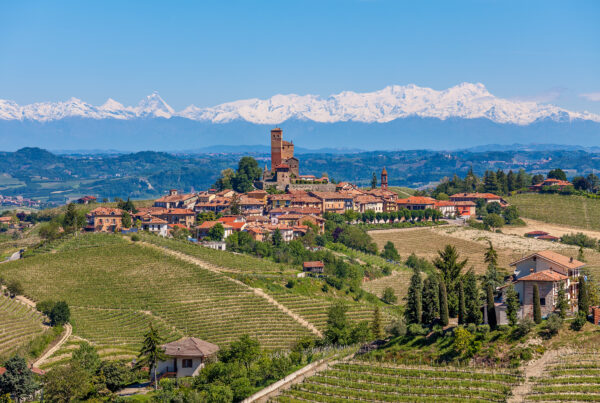Print and read offline instead.
In this report:
- Fine wine performed better than other safe-haven assets such as gold in May.
- Bordeaux and Burgundy benefitted from narrowing buyers’ focus.
- Some of the best-performing wines came from the Rhône last month.
- Lisa Perrotti-Brown MW awarded higher scores to Sauternes than red Bordeaux in 2021.
- Buyers are finding value in 2014 and 2019 Bordeaux during this year’s En Primeur campaign.
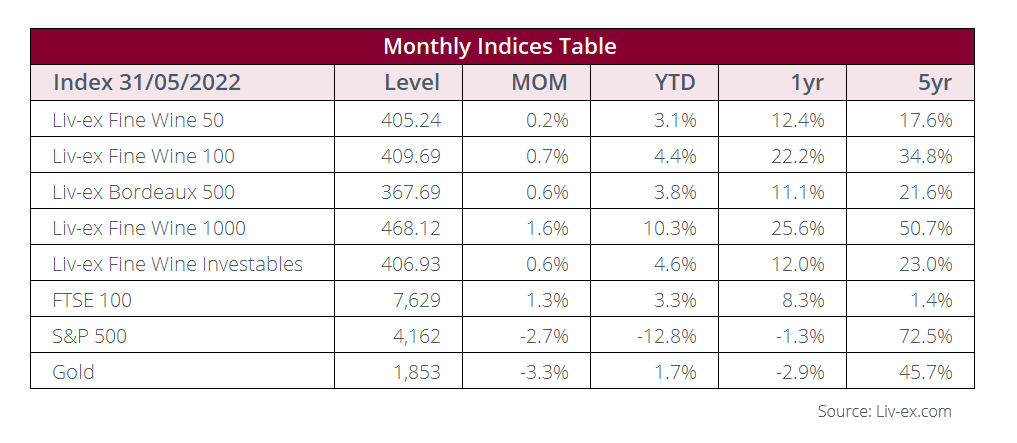
Fine wine outperforms gold as inflation rises
Fine wine prices continued their steady ascent in May, while US stocks closed a tumultuous month at similar levels to where they had started. The Liv-ex 100 went up 0.7% – the same increase as the previous two months – while the Liv-ex 1000 made a more notable move of 1.6%. The indices outperformed the traditional safe-haven gold, proving that fine wine can perform well during inflation and economic uncertainty.
Grand Cru Burgundy was once again in focus, comprising many of the Liv-ex 100 and Liv-ex 1000‘s best price performers in May. Year-to-date, the Burgundy 150 sub-index is up 22.3%, outperforming all other regions and the broader market. The 2019 Burgundy vintage was met with the most demand in May.
The 2019 was also the most traded Bordeaux vintage by both value and volume. The 2014 ranked second by volume, as buyers noticed the value it offers in relation to this year’s En Primeur campaign. The 2014s are also the best-rated Bordeaux ‘off’ vintage since 2005 and the second lowest-priced vintage. The final section of this report examines the En Primeur campaign so far and the question of value in more detail.
Regional trade share in May
The chart below shows the regional breakdown of secondary market trade by value in May this year.
Burgundy (27.3%) and Bordeaux (34.3%) increased their share from 22.6% and 33.2% in April respectively, as buyers’ focus narrowed. The Rhône (5.7%) and the ‘others’ (5.3%) also enjoyed increased demand. Trade within the ‘others’ was dominated by Spain (1.1%), United Kingdom (0.8%) – thanks to single malt whiskies and sparkling wine – and Australia (0.7%).
Champagne maintained its level at 11.9%, while Tuscany, Piedmont and the USA dipped on the previous month.
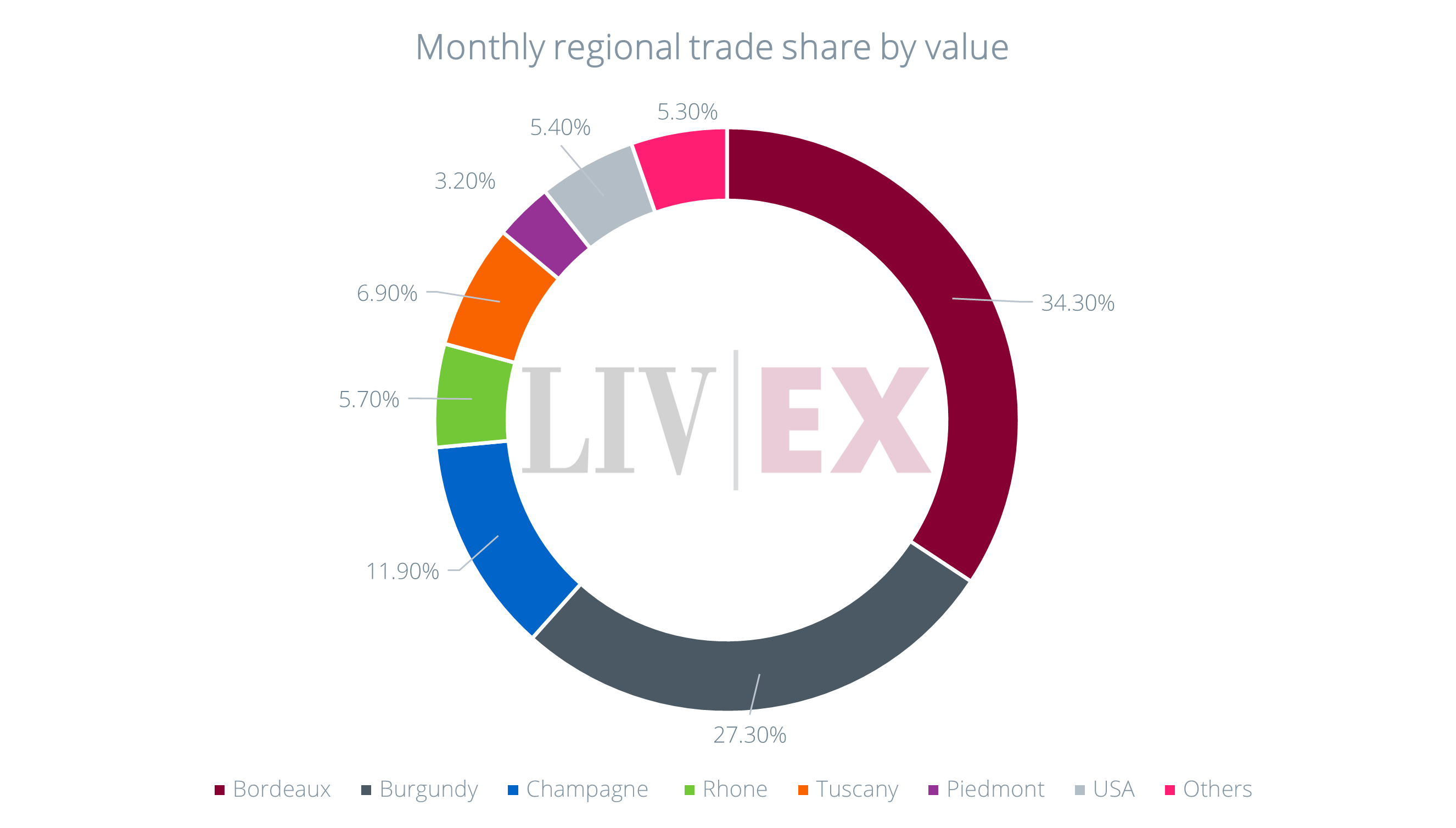
The best performing wines from the Rhône
The Rhône 100 was the second-best performing Liv-ex 1000 sub-index in May, increasing 2.3%. The region’s wines also saw increased secondary market demand. The 2016 vintage led trade by value, while 2020 saw big volume purchases. Some of the top-performing wines, however, came from vintages over a decade-old.
The wines of E. Guigal from Côte-Rôtie took three out of the top five spots. Château d’Ampuis’ 2011 and 2012 vintages went up 20.0% and 18.4% respectively. The 2009 La Landonne, which boasts 100-points from Robert Parker and Jeb Dunnuck, also rose 17.1%.

Perrotti-Brown stresses the value of Sauternes
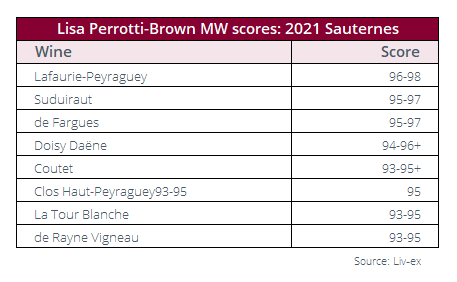
As part of her Bordeaux 2021 coverage at The Wine Independent, Lisa Perrotti-Brown MW published her scores for the vintage’s Sauternes separately to the reds.
Of all the Bordeaux appellations, Sauternes and Barsac were hardest hit by the year’s frosts, with some estates (such as Château Climens) losing their entire crop.
Hail and rot throughout the season reduced the final yield further but Perrotti-Brown noted that the results are: ‘Complex, multi-layered wines that possess impressive botrytis signatures, and they are rich yet well-balanced by laser-fine backbones of acidity.’
She continued: ‘Those looking for something from this vintage to put in their cellars and who love this style of wine shouldn’t hesitate to buy.’
Her top score went to Château Lafaurie-Peyraguey, which she said ‘delivers wonderful tension’ and finishes ‘with impressive persistence’.
More estates withdraw from St-Emilion classification
Two more estates have withdrawn from the up-coming St-Emilion Classification. The biggest name from the pair was Château La Gaffelière, widely considered a rising star of the appellation.
The chart below shows La Gaffelière’s scores over the last 10 vintages (2012-2021) versus the average Benchmark Critic score for the four Premier Grand Crus Classé ‘A’ estates (Ausone, Angélus, Cheval Blanc and Pavie) over the same period. It shows how La Gaffelière has closed the gap on the premier crus from a critical standpoint; even overtaking them in 2020-2021.
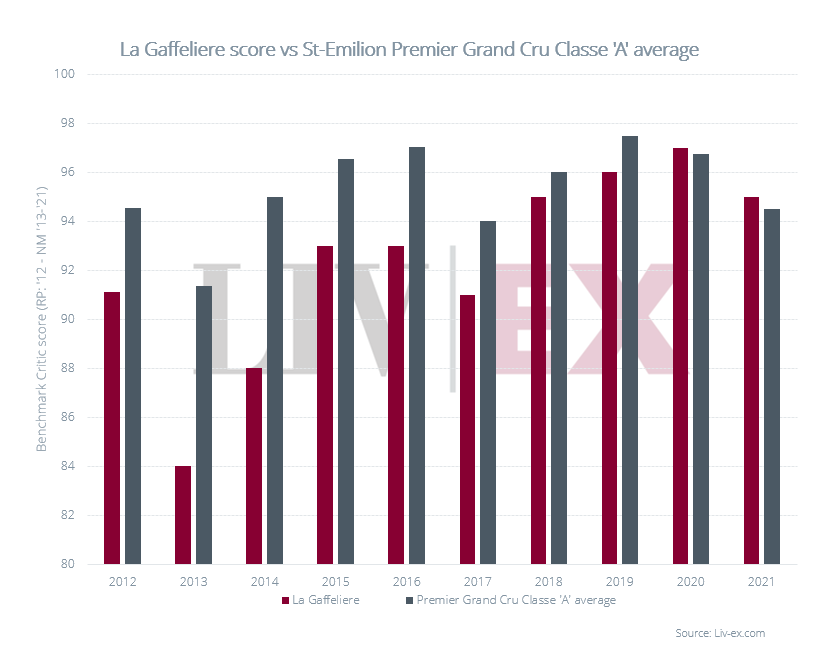
An article by Colin Hay in The Drinks Business suggested that the estate had received feedback from the classification panel that it was going to lose its Premier Grand Cru Classé ‘B’ status (which it has held since 1955), with both the integrity of its terroir and quality of its wines called into question.
Faced with the dossier, proprietor Alexandre de Malet Rocquefort told Terre de Vins that he and his family were left with no choice but to quit the classification.
He told the publication that: ‘In any case, since the withdrawal of our region’s two ‘lighthouses’, Ausone and Cheval Blanc, we already felt like orphans. This was the final straw.’ The panel, he said were, ‘completely out of touch with the changes that have been taking place at La Gaffelière over many years and the scores our wines have been given’ (see chart above).
On 6th June, Château Croque Michotte announced it was also quitting the process, saying that the classification panel had turned the procedure into a ‘competition about oeno-tourism and big media budgets that have nothing to do with wine’.
Five estates have now publicly declared they will not be included in the 2022 classification, with three of the four the Premier Grand Cru Classé ‘A’ estates having withdrawn themselves, Ausone and Cheval Blanc last year and Angélus this Janaury.
Unhappy estates withdrawing from the classification means that the 2022 rankings are unlikely to be plagued by the legal wranglings that followed the 2012 classification. However, what it means for the future of the Saint-Emilion grand cru system remains to be seen. The full classification is due to be announced in September of this year.
Have the 2021 Bordeaux En Primeur releases offered value so far?
The Bordeaux En Primeur 2021 campaign is quickly approaching its midway point, and the overall pricing trend has been to stay the same as last year.
Looking at the leading estates Liv-ex tracks at En Primeur, 45 have been released (at the time of writing). Twenty-eight of these, including Château Palmer and Château Lynch-Bages, have been at the same price as their 2020 wines. Eleven estates, like Château Lafite Rothschild, have released at discounts on last year. The remaining six wines have increased their prices, with Clos du Marquis’ 12.9% increase being the biggest so far.
Pricing expectations
According to the results of the annual Liv-ex En Primeur survey, the majority of merchants expected the new releases to be priced 2.7% lower than the 2020 vintage on average. The question of pricing featured heavily in critics’ reports too. In his Vinous report, Antonio Galloni mentioned rising interest rates and the possibility of global recession as reasons why owners should be cautious with pricing, but also considered inflation, rising costs and wine shortages, as reasons why prices might justifiably increase.
Understanding value
The question of value, however, is not necessarily tied to price changes on last year. Rather it is dependent on critic scores, age and historic market performance. As our Fair Value methodology demostrates, a wine can go up in price from the previous year and still offer better value if its quality is markedly better or previous releases have risen in value. The methodology uses regression analysis to measure the relationship between price and quality or age and establish the fair price of a wine based on its critic score and vintages (since 2010) already available in the market.
Fair Value so far
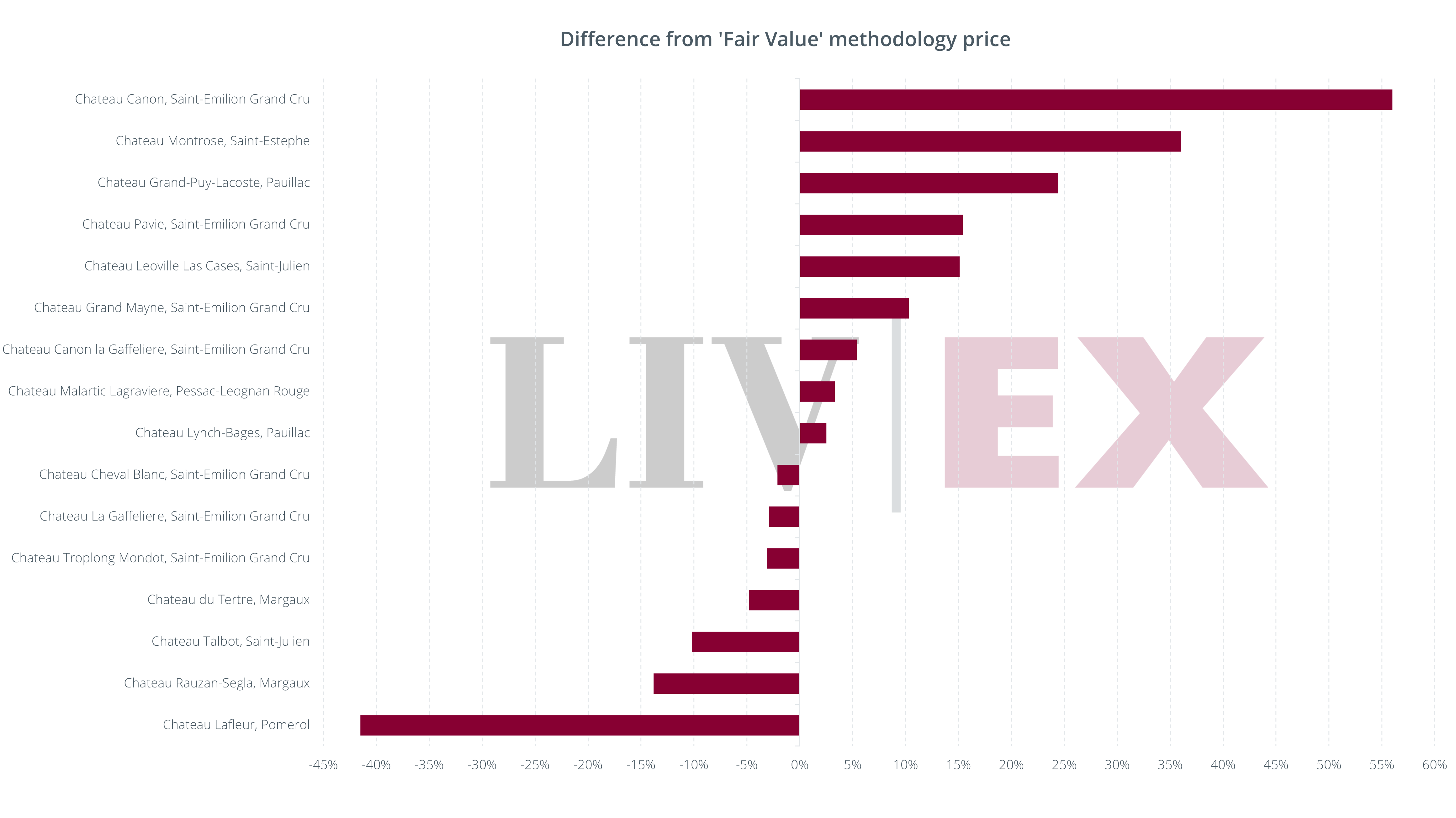
The chart above shows a selection of 16 major Bordeaux 2021 releases, which have strong correlation (over 50%) to Benchmark Critic scores (2005-2012 Robert Parker, 2013-2021 Neal Martin).
The chart shows how far the 2021 wines were from the price implied by the Fair Value methodology. There is an almost even split between wines that have been released at a premium and ones that represented Fair Value.
Among the best-value releases were Château Lafleur and Rauzan-Ségla. Their 2021s were positioned below many other physically available wines for those lucky enough to have secured an allocation.
Meanwhile, wines like Canon and Montrose would seem to offer better value in already physical vintages like 2014 and 2019.
Looking back during a ‘futures’ campaign
A recurring theme, linked to the value offered by the new releases, is the price of the physical alternatives. For many of the releases so far, the 2014 and 2019 vintages represent a more attractive buy. The high-quality 2019s were released at the start of the Covid-19 pandemic, and as a result, were largely offered at lower prices. The 2014, meanwhile, is the best-rated ‘off’ Bordeaux vintage and the second-lowest priced since 2005. As the En Primeur campaign unfolds, the two vintages have been leading Bordeaux’s secondary market trade by volume.
For now there appear to have been few releases that have offered compelling reasons for collectors to part with their money and return to buying en primeur.
Liv-ex analysis is drawn from the world’s most comprehensive database of fine wine prices. The data reflects the real time activity of Liv-ex’s 580+ merchant members from across the globe. Together they represent the largest pool of liquidity in the world – currently £100m of bids and offers across 16,000 wines. Independent data, direct from the market.






